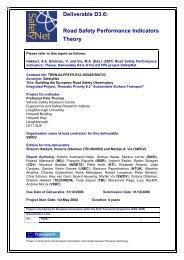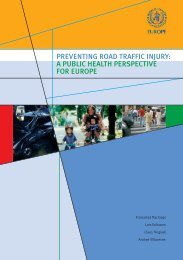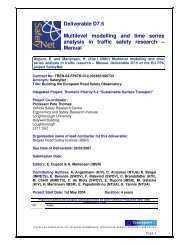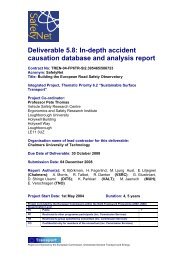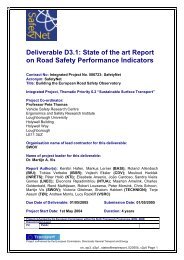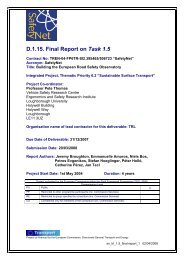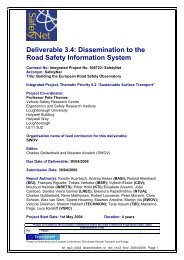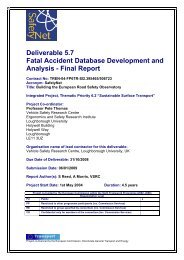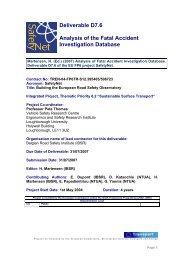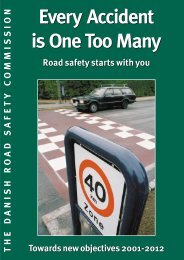Glossary of Data Variables for Fatal and accident causation ... - ERSO
Glossary of Data Variables for Fatal and accident causation ... - ERSO
Glossary of Data Variables for Fatal and accident causation ... - ERSO
Create successful ePaper yourself
Turn your PDF publications into a flip-book with our unique Google optimized e-Paper software.
Manual For SafetyNet <strong>accident</strong> <strong>causation</strong> system (SNACS)<br />
6.2 Introduction<br />
The analysis method SNACS (SafetyNet Accident Causation System) is a tool<br />
<strong>for</strong> analysing traffic <strong>accident</strong>s <strong>and</strong> incidents through a systematic <strong>and</strong> balanced<br />
description <strong>of</strong> the factors that can contribute to the development <strong>of</strong> an <strong>accident</strong><br />
or incident scenario. The goal <strong>of</strong> the SNACS analysis is to create an<br />
underst<strong>and</strong>ing <strong>of</strong> <strong>accident</strong> scenarios which can function as a base <strong>for</strong> <strong>accident</strong><br />
preventative work.<br />
SNACS is based on the existing method DREAM 3 . DREAM, in turn, is an<br />
adaptation to the area <strong>of</strong> vehicle safety <strong>of</strong> a model called CREAM 4 . The<br />
DREAM method has a Human-Technology-Organisation perspective, which<br />
implies that <strong>accident</strong>s happen when the dynamic interaction between people,<br />
technologies <strong>and</strong> organisations fails in one way or another, <strong>and</strong> that there is a<br />
variety <strong>of</strong> interacting causes creating the <strong>accident</strong>. The latter part particularly<br />
stresses one <strong>of</strong> the most important issues <strong>of</strong> the WP5.2 project; to be able to<br />
survey the causes <strong>of</strong> the <strong>accident</strong>s.<br />
6.3 The Accident model behind SNACS<br />
An <strong>accident</strong> model is an abstract conceptual representation <strong>of</strong> the occurrence<br />
<strong>and</strong> development <strong>of</strong> an <strong>accident</strong>. It describes how <strong>and</strong> why <strong>accident</strong>s happen, it<br />
defines possible causes <strong>and</strong> interactions, <strong>and</strong> it directs data collection <strong>and</strong><br />
analysis, as well as the selection <strong>of</strong> countermeasures. On every occasion where<br />
an <strong>accident</strong> analysis is carried out, a more or less explicit underlying <strong>accident</strong><br />
model can be identified. If the model is inadequate <strong>for</strong> describing the problems<br />
<strong>of</strong> the domain, the <strong>accident</strong> analysis <strong>and</strong> countermeasure selection will be<br />
inadequate too 5 .<br />
Modern road traffic is a complex, rapidly changing <strong>and</strong> dynamic environment,<br />
which makes it a good example <strong>of</strong> a so called socio-technical system. In this<br />
system, the task <strong>of</strong> the driver is gradually becoming more <strong>and</strong> more<br />
complicated, while at the same time the dem<strong>and</strong>s <strong>for</strong> a reduction in the number<br />
<strong>of</strong> <strong>accident</strong>s are increasing. This leads to certain requirements that need to be<br />
met by an <strong>accident</strong> model <strong>for</strong> modern road traffic:<br />
• It needs to provide adequate concepts <strong>for</strong> describing the factors that can<br />
lead to an <strong>accident</strong> within the domain. Because <strong>of</strong> the interdependencies<br />
<strong>and</strong> the tight structural coupling between the elements <strong>of</strong> modern road<br />
traffic, the model also needs to describe how the contributing factors<br />
interact with each other.<br />
3 Ljung, M., DREAM – Driving Reliability <strong>and</strong> Error Analysis Method, Linköping University, 2002<br />
4 Hollnagel, E., CREAM - Cognitive Reliability <strong>and</strong> Error Analysis Method, Elsevier Science,<br />
Ox<strong>for</strong>d, 1998<br />
5 Huang, Ljung, Hollnagel & S<strong>and</strong>in, Accident models <strong>for</strong> modern road traffic – changing times<br />
creates new dem<strong>and</strong>s, IEEE International Conference on Systems, Man & Cybernetics, Hague,<br />
Netherl<strong>and</strong>s, 2004<br />
Page 116 <strong>of</strong> 215



